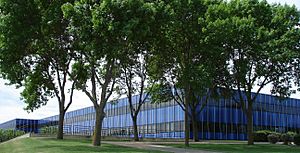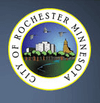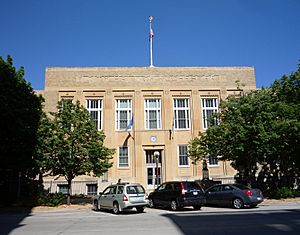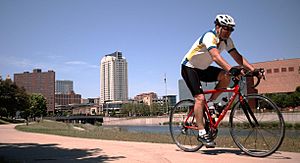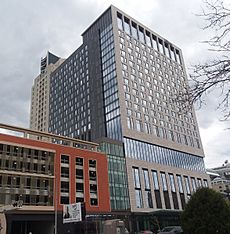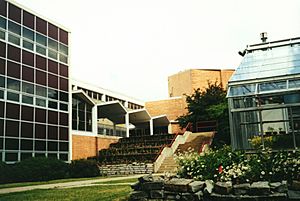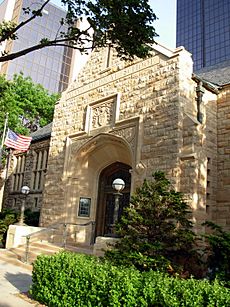Rochester, Minnesota facts for kids
Quick facts for kids
Rochester, Minnesota
|
|||
|---|---|---|---|
| City of Rochester | |||
|
From top to bottom: Rochester Skyline, View from outside the local IBM Complex
|
|||
|
|||
| Nickname(s):
Med City, Roch
|
|||
| Motto(s):
America's City of Care and Innovation
|
|||
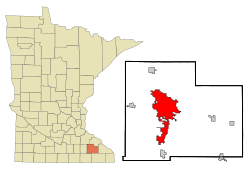
Location of the city of Rochester
within Olmsted County, Minnesota |
|||
| Country | |||
| State | |||
| County | Olmsted | ||
| Founded | 1854 | ||
| Area | |||
| • City | 55.87 sq mi (144.70 km2) | ||
| • Land | 55.58 sq mi (143.95 km2) | ||
| • Water | 0.29 sq mi (0.75 km2) | ||
| Elevation | 1,030 ft (401.4 m) | ||
| Population
(2020)
|
|||
| • City | 124,599 | ||
| • Rank | 233rd in the United States 3rd in Minnesota |
||
| • Density | 2,184.15/sq mi (843.31/km2) | ||
| • Metro | 226,329 (203rd) | ||
| Time zone | UTC−6 (CST) | ||
| • Summer (DST) | UTC−5 (CDT) | ||
| ZIP codes |
55901–55906
|
||
| Area code(s) | 507 | ||
| FIPS code | 27-54880 | ||
| GNIS feature ID | 0650180 | ||
Rochester is a city in the U.S. state of Minnesota and the county seat of Olmsted County. Located on rolling bluffs on the Zumbro River's south fork in Southeast Minnesota, the city is the home and birthplace of the renowned Mayo Clinic.
According to the 2020 United States Census, the city had a population of 121,395 making it Minnesota's third-largest city. The Rochester metropolitan area, which also includes the nearby rural agricultural areas, has a population of 226,329.
Contents
History
Rochester was founded in 1854, and platted in 1855. Rochester developed as a stagecoach stop between Saint Paul, Minnesota, and Dubuque, Iowa. When the railroad arrived in the 1860s, it brought new residents and business opportunities. In 1863, Dr. William W. Mayo arrived as the examining surgeon for draftees in the Civil War. The community was named after Rochester, New York.
On August 21, 1883, the Great Tornado demolished much of Rochester, leaving 37 dead and about 200 injured. As there was no medical facility at the time, Mayo and his two sons worked together to care for the wounded. Donations of $60,000 were collected and the Sisters of St. Francis, assisted by Mayo, opened a new facility named St. Marys Hospital in 1889. The Mayo practice grew and is today among the largest and most well-respected medical facilities in the world. Many famous people from around the world, including former Presidents Franklin D. Roosevelt, Harry S. Truman, George H. W. Bush, Gerald Ford, and Ronald Reagan, have visited Rochester as patients of the Mayo Clinic. Rochester has also been hit by two F4 tornadoes since 1950 (the first on May 10, 1953 and the other on September 16, 1962.) Rochester celebrated its sesquicentennial in 2004.
Geography
Rochester lies alongside the South Fork of the Zumbro River. According to the United States Census Bureau, the city has a total area of 54.75 square miles (141.80 km2), of which 54.59 square miles (141.39 km2) of it is land and 0.16 square miles (0.41 km2) is water. The city is located 85 miles (137 km) southeast of Minneapolis-St. Paul.
Rochester is in Olmsted County, one of only four counties in Minnesota without a natural lake. Artificial lakes exist in the area, including Silver Lake, a dammed portion of the South Fork Zumbro River just below the convergence with Silver Creek near the city center. Silver Lake was once used as a cooling pond when the coal-burning power plant was operated by Rochester Public Utilities, at the lake. When operational, the RPU coal plant's heated water output prevented the lake from generally freezing over during the winter months; attracting large numbers of migrating giant Canada geese.
Rochester has many parks; the largest being Silver Lake and Soldiers Field. A major flood in 1978 led the city to embark on an expensive flood-control project that involved altering many nearby rivers and streams.
Climate
Rochester features a humid continental climate, with hot summers and very cold winters. The city features four distinct seasons. Rochester sees on average 30 inches (760 mm) of rainfall and 48 inches (120 cm) of snowfall per year. Significant snow accumulation is common during the winter months. Spring and fall are transitional seasons, with a general warming trend during the spring and a general cooling trend during the fall. However, it is not uncommon to see some snowfall during the early months of spring and the later months of fall. Rochester is the second windiest city in the United States, with wind speeds averaging 12.6 mph. January and April are the windiest months on average, according to The Weather Channel.
| Climate data for Rochester, Minnesota | |||||||||||||
|---|---|---|---|---|---|---|---|---|---|---|---|---|---|
| Month | Jan | Feb | Mar | Apr | May | Jun | Jul | Aug | Sep | Oct | Nov | Dec | Year |
| Record high °F (°C) | 58 (14) |
63 (17) |
82 (28) |
92 (33) |
106 (41) |
105 (41) |
108 (42) |
100 (38) |
100 (38) |
93 (34) |
77 (25) |
63 (17) |
108 (42) |
| Average high °F (°C) | 24 (−4) |
28 (−2) |
40 (4) |
57 (14) |
69 (21) |
78 (26) |
84 (29) |
81 (27) |
71 (22) |
58 (14) |
42 (6) |
27 (−3) |
55 (13) |
| Average low °F (°C) | 8 (−13) |
12 (−11) |
24 (−4) |
36 (2) |
47 (8) |
57 (14) |
61 (16) |
59 (15) |
50 (10) |
38 (3) |
26 (−3) |
12 (−11) |
36 (2) |
| Record low °F (°C) | −42 (−41) |
−35 (−37) |
−31 (−35) |
5 (−15) |
20 (−7) |
31 (−1) |
40 (4) |
32 (0) |
22 (−6) |
−6 (−21) |
−24 (−31) |
−39 (−39) |
−42 (−41) |
| Average rainfall inches (mm) | 0.87 (22) |
0.83 (21) |
1.89 (48) |
3.23 (82) |
3.62 (92) |
4.69 (119) |
4.57 (116) |
4.53 (115) |
3.46 (88) |
2.24 (57) |
1.93 (49) |
1.22 (31) |
33.08 (840) |
| Average snowfall inches (cm) | 12 (30) |
9 (23) |
9 (23) |
3 (7.6) |
0 (0) |
0 (0) |
0 (0) |
0 (0) |
0 (0) |
1 (2.5) |
6 (15) |
13 (33) |
53 (130) |
| Source 1: weatherbase.com | |||||||||||||
| Source 2: U.S. climate data | |||||||||||||
Demographics
| Historical population | |||
|---|---|---|---|
| Census | Pop. | %± | |
| 1860 | 1,424 | — | |
| 1870 | 3,953 | 177.6% | |
| 1880 | 5,103 | 29.1% | |
| 1890 | 5,321 | 4.3% | |
| 1900 | 6,843 | 28.6% | |
| 1910 | 7,844 | 14.6% | |
| 1920 | 13,722 | 74.9% | |
| 1930 | 20,621 | 50.3% | |
| 1940 | 28,312 | 37.3% | |
| 1950 | 29,885 | 5.6% | |
| 1960 | 40,663 | 36.1% | |
| 1970 | 53,766 | 32.2% | |
| 1980 | 57,890 | 7.7% | |
| 1990 | 70,745 | 22.2% | |
| 2000 | 85,806 | 21.3% | |
| 2010 | 106,769 | 24.4% | |
| 2020 | 121,395 | 13.7% | |
| U.S. Decennial Census | |||
As of 2019, there were 118,935 people in 47,097 households residing in the city. The population density was 1,955.8 inhabitants per square mile (755.1/km2). There were 45,683 housing units at an average density of 836.8 per square mile (323.1/km2). The racial makeup of the city was 79.4% White, 8.2% African American, 0.5% Native American, 7.3% Asian, 2.0% from other races, and 3.4% from two or more races. Hispanic or Latino of any race were 5.9% of the population.
In terms of ancestry, the 2005–2007 American Community Survey found German Americans to be the largest single ethnic group in Rochester, making up 35.5% of the city's population. Norwegian Americans made up 15.9%, while Irish Americans contributed to 11.6% of the city's populace. English Americans made up 8.2% of the population and Swedish Americans were 5.0% of the city's population. In the mid-1980s Rochester had fewer than 40 Hmong persons. The 1990 United States Census counted 200 Hmong persons in Rochester. This increased to 300 by 1998. Cathleen Jo Faruque, author of "Migration of Hmong to Rochester, Minnesota: Life in the Midwest," wrote in 2003 that there was "every indication that this trend will continue".
There were 43,025 households, of which 31.9% had children under the age of 18 living with them, 49.4% were married couples living together, 9.5% had a female householder with no husband present, 3.5% had a male householder with no wife present, and 37.6% were non-families. 30.1% of all households were made up of individuals, and 8.8% had someone living alone who was 65 years of age or older. The average household size was 2.42 and the average family size was 3.04.
The median age in the city was 35 years. 24.8% of residents were under the age of 18; 8.3% were between the ages of 18 and 24; 29.4% were from 25 to 44; 24.8% were from 45 to 64; and 12.7% were 65 years of age or older. The gender makeup of the city was 48.4% male and 51.6% female.
As of the 2011–2015 American Community Survey, the median household income was $68,023.
Arts and culture
A number of Rochester buildings are on the National Register of Historic Places, including the historic Chateau Theatre, which in 2015 was bought by the city for preservation, and Avalon Music, formerly a hotel important in the local civil rights movement.
The Rochester Art Center is located downtown, just south of the Mayo Civic Center.
In the summer, every Thursday the city puts on "Thursdays on First" where local restaurants and artists can set up booths all along First Avenue downtown Rochester. There are a few stages where bands perform and provide entertainment. There are also a number of street musicians sitting on walls or standing on the sidewalks.
The oldest cultural arts institution in the community, Rochester Symphony Orchestra & Chorale was founded in 1919 as a professional performing arts organization called the Rochester Orchestra. Its earliest ensemble — the Lawler-Dodge Orchestra — was founded in 1912 as a volunteer orchestra, driven by Daisy Plummer, wife of world-famous Mayo Clinic physician, Dr. Henry Plummer, and directed by Harold Cooke. In early years, the Orchestra appeared in the former Chateau Theatre where they performed background music for silent movies.
Parks and recreation
Rochester's park system is large, with more than 100 sites covering 5 square miles (13 km2). The city maintains 85 miles (137 km) of paved trails. The south terminus of the Douglas State Trail is built on an abandoned railroad grade.
Infrastructure
Transportation
Rochester is served by three U.S. highways (U.S. 14, U.S. 52, and U.S. 63), and the southern edge of Rochester is skirted by Interstate Highway 90 and State Highway 30. Olmsted County Highway 22 is also a main highway in the city. A combination of skyways and subterranean walkways link most downtown buildings, which residents often use to avoid harsh winter weather conditions. Public bus transit is run by Rochester Public Transit. Its operations are carried out by First Transit. The city Rochester encourages biking through its numerous trails and to facilitate the biking program all the city buses have bike carriers for easy transportation of bikes.
Rochester International Airport is located seven miles south of downtown. The airport is the second busiest commercial airport in Minnesota. It has direct flights to Atlanta, Chicago, Denver, and Minneapolis, with occasional charter flights servicing Riverside Resort in Laughlin, Nevada. Nonstop flights to Phoenix and Fort Myers will begin in early 2022.
Rochester has a shuttle service connecting to the Minneapolis St. Paul International Airport by Rochester Shuttle Service and Groome Transportation (formerly Go Rochester Direct).
Rochester's last passenger rail service, to Chicago to the southeast and Rapid City, South Dakota to the west, ended when the Chicago and North Western Railway's Rochester 400 streamliner ended service in 1963. The closest Amtrak station is at Winona, Minnesota, 45 miles to the east. Travelers are able to purchase tickets from Amtrak for a shuttle bus that connects with the daily Empire Builder at La Crosse, Wisconsin.
Rochester is planning a 2.6 mi (4.2 km) bus rapid transit line known as Link. The route will have seven stations along 2nd Street SW and is expected to open in 2025. It will be the first bus rapid transit line in Minnesota outside the Twin Cities.
Major highways
 US 14 – U.S. Route 14
US 14 – U.S. Route 14 US 52 – U.S. Route 52
US 52 – U.S. Route 52 US 63 – U.S. Route 63
US 63 – U.S. Route 63 I-90 – Interstate 90
I-90 – Interstate 90 MN 30 – Minnesota State Highway 30
MN 30 – Minnesota State Highway 30
Awards and rankings
The city had long been a fixture on Money magazine's "Best Places to Live" index, and was ranked number 67 on the 2006 list, and in the top 3, including number one multiple times, from 1993-1997.
Rochester ranked second in Quality of Life by American City Business Journal.
Rochester ranked sixth in Kiplinger's Personal Finance magazine's 10 Best Cities for the Next Decade.
Golf Digest and Golf for Women both ranked Rochester as the fifth best golf market in the midwest in 2006.
In 2009, US News and World Report ranked Rochester in the Top Ten Best Places to Grow Up and ninth for Best Cities for job seeking retirees.
Rochester was ranked the 5th best city to retire in by the Milken Institute.
Economy
Mayo Clinic forms the core of Rochester's economy. As of 2016, it employs 34,180 people and draws more than 2 million visitors annually. The clinic's many facilities, along with hotels, restaurants and retail stores, comprise nearly all of the city's downtown. Excluding the state government, Mayo Clinic is the largest employer in Minnesota. Other care providers, including the Rochester Federal Medical Center, are significant employers.
IBM's Rochester campus is an R&D and manufacturing center. It designed and produced IBM's midrange computer series, has been home to the first Blue Gene prototype, and contributed the servers for Roadrunner. Seven employees at the Rochester IBM campus created IBM Employees Credit Union, which is now Think Mutual Bank, a chain of banks in the Rochester and Twin Cities metropolitan areas.
The economy of Rochester is also influenced by the agricultural nature of the region. There are multiple dairy producers that are active in the area. In addition, Kerry Flavours and Ingredients, a subsidiary of the global Irish company called Kerry Group, maintains a production plant in Rochester that specializes in fermented ingredients, found in breads, meats and other processed foods.
| No. | Employer | No. of Employees |
|---|---|---|
| 1 | Mayo Clinic | 34,660 |
| 2 | IBM | 2,791 |
| 3 | Rochester Public Schools | 2,727 |
| 4 | City of Rochester | 1,291 |
| 5 | Olmsted County | 1,279 |
| 6 | Olmsted Medical Center | 1,249 |
| 7 | McNeilus Truck & Manuf. | 1,214 |
| 8 | Charter Communications | 902 |
| 9 | Kahler Hotels | 680 |
| 10 | Crenlo | 600 |
| 11 | Benchmark Electronics | 562 |
| 12 | Rochester Community and Technical College | 500 |
| 13 | Federal Medical Center, Rochester | 450 |
| 14 | Reichel Foods | 450 |
Destination Medical Center
In 2013, Governor Mark Dayton signed a bill known as Destination Medical Center (DMC). It intends to increase Minnesota's tax base, and promote business and economic growth throughout the state. Because of this legislation, The Mayo Clinic will invest in $3.5 billion to upgrade patient rooms, add additional workspace, and build research and administrative buildings.
The main developments of this plan will be in the DMC sub-districts. The Downtown Waterfront district will cover The Government Center, The Civic Center, and most areas near the Zumbro River. The Central Station district includes Central Park and most of Civic Center Drive, aimed to become a transportation hub of the city. St. Marys Place will cover St. Marys hospital and St. Marys Park, as well as most of 2nd Street. The Heart of the City will feature the Mayo Clinic campus and major residential, commercial, and retail companies. The Discovery Square area will include scientific and technology research facilities. Lastly, The UMR and Recreation district will feature Soldiers Field and the University of Minnesota Rochester campus.
Sports
| Team | League | Venue |
|---|---|---|
| Rochester Honkers | Northwoods League, Baseball | Mayo Field |
| Rochester Grizzlies | NA3HL, Ice Hockey | Rochester Recreation Center |
| Med City Freeze | Southern Plains Football League, Semi-Pro Football | Rochester Regional Stadium |
| Rochester Med City FC | National Premiere Soccer League, Soccer | Rochester Regional Stadium at Rochester Community and Technical College |
Education
Rochester Public Schools enroll 16,300 students in 23 public primary and secondary schools. The city is divided into three public high school attendance zones: John Marshall, Mayo and Century. Private schools in the city include Lourdes, Schaeffer Academy, and Rochester Central Lutheran School amongst various smaller private religious schools. Studio Academy, a fine arts-focused charter school operated for 10 years in Rochester and closed its doors in 2011 upon losing its charter. The Rochester STEM Academy opened in 2011, occupying the former Studio Academy building.
Higher education in Rochester had been concentrated around the former University Center Rochester in the city's southeast outskirts, where Rochester Community and Technical College shares a campus with a branch of Winona State University. The University of Minnesota offered degrees through UCR until 2007, when the University of Minnesota Rochester was established downtown. Branches of Augsburg University and College of St. Scholastica are also in Rochester, as are branches of Winona State University and St. Mary's University. The Mayo Clinic offers graduate medical education and research programs through the Mayo Clinic Alix School of Medicine, Mayo Clinic Graduate School of Biomedical Sciences, and the Mayo Clinic School of Health Sciences.
According to the United States Census Bureau 2011–2015, the number of high school graduates or higher, percent of persons age 25 years+ was 94.1%. The number of bachelor's degree or higher percent of persons age 25+ was 41.3%.
Images for kids
See also
 In Spanish: Rochester (Minesota) para niños
In Spanish: Rochester (Minesota) para niños



